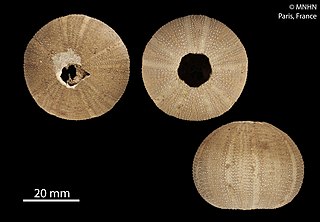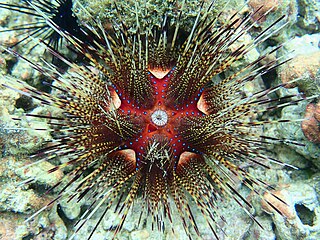
Astropyga radiata, the red urchin, fire urchin, false fire urchin or blue-spotted urchin, is a species of sea urchin in the family Diadematidae. It is a large species with long spines and is found in the tropical Indo-Pacific region. It was first described in 1778 by the German naturalist Nathaniel Gottfried Leske.

The Echinacea are a superorder of sea urchins. They are distinguished by the presence of a rigid test, with ten buccal plates around the mouth, and solid spines. Unlike some other sea urchins, they also possess gills. The group is a large one, with species found worldwide.

The Echinothurioida are an order of sea urchins in the class Echinoidea. Echinothurioids are distinguished from other sea urchins by the combination of a flexible test and hollow spines. The membrane around the mouth contains only simple plates, in contrast to the more complex mouth parts of their close relatives, the Diadematoida. They are nearly all deepsea dwellers.

Asthenosoma marisrubri aka Red Sea fire urchin and toxic leather sea urchin , is a relatively common sea urchin with a widespread distribution in the Indo-Pacific, and was till 1998 considered a color variant of Asthenosoma varium. Sea urchins are close relatives of starfish, crinoids, brittle stars and sea cucumbers, all being echinoderms.
Acanthocidaris maculicollis is a species of sea urchin of the family Cidaridae. Their armour is covered with spines. It came from the genus Acanthocidaris and lives in the sea. Acanthocidaris hastingeria was first scientifically described in 1904 by de Meijere.
Amblypneustes elevatus is a species of sea urchin of the family Temnopleuridae. Their armour is covered with spines. It came from the genus Amblypneustes and lives in the sea.

Amblypneustes ovum is a species of sea urchin of the family Temnopleuridae. Their armour is covered with spines. It came from the genus Amblypneustes and lives in the sea. Amblypneustes ovum was first scientifically described in 1816 by Jean-Baptiste de Lamarck.

Amblypneustes pallidus is a species of sea urchin of the family Temnopleuridae. Their armour is covered with spines. It came from the genus Amblypneustes and lives in the sea. Amblypneustes pallidus was first scientifically described in 1816 by Jean-Baptiste de Lamarck.
Apatopygus recens is a species of sea urchin of the family Apatopygidae. Their armour is covered with spines. It is placed in the genus Apatopygus and lives in the sea. Apatopygus recens was first scientifically described in 1836 by Milne-Edwards, French zoologist.
Aphanopora echinobrissoides is a species of sea urchin of the family Neolampadidae. Their armour is covered with spines. It is placed in the genus Aphanopora and lives in the sea. Aphanopora echinobrissoides was first scientifically described in 1903 by de Meijere.

Asterechinus elegans is a species of sea urchin of the family Trigonocidaridae. Their armour is covered with spines. It is placed in the genus Asterechinus and lives in the sea. Asterechinus elegans was first scientifically described in 1942 by Ole Theodor Jensen Mortensen.
Asthenosoma dilatatum is a species of sea urchin of the family Echinothuriidae. Their armour is covered with spines. It is placed in the genus Asthenosoma and lives in the sea. Asthenosoma dilatatum was first scientifically described in 1934 by Ole Theodor Jensen Mortensen.
Allopontonia brockii is a small commensal shrimp in the family Palaemonidae.

Astropyga pulvinata is a species of sea urchins of the family Diadematidae. Their armour is covered with spines. Astropyga pulvinata was first scientifically described in 1816 by Jean-Baptiste de Lamarck.
Caenopedina indica is a species of sea urchins of the Family Pedinidae. Their armour is covered with spines. Caenopedina indica was first scientifically described in 1903 by de Meijere.











